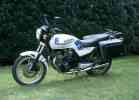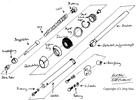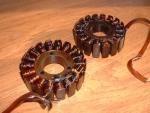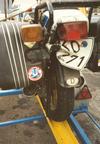Jörgs Suzuki GSX400/250 Page
Home |
Motorcycle Main page
This page is about my first motorcycles, a Suzuki GSX250E
and a GSX400E. I owned the GSX250 from 1983 to 1986
(57000 km), followed by the GSX400 from 1986 to 1990 (103000 km).
Please note that this is now three to four decades in the past. Except for the material
on these pages, I do not have documentation of these two bikes left, so please do not ask
me where to find parts etc. I suggest to ask your friendly Suzuki dealer ...
GSX400E |
GSX250E |
Modifications |
Chain Box |
Links
Introduction



The Suzuki GSX400E was the successor of my GSX250.
I received it, new and right out of the shop, in April 1986. At that time it cost some
4200 DM - a very reasonable price for such a bike. It was the version with 27 HP,
not the "open" one with 42 HP.
I kept it for four years and we made 103000 km together in that time.
By the way, the photo on the right shows the bike just a few km
before I actually sold it. Still in excellent shape!
With my experience from the GSX250E, it was nice to see that Suzuki had learned and improved:
Corrosion problems were almost absent, the frame was much more stable and many little details
were improved. The instruments now included a gear indicator, separate controls for the left
and right turn signal and the choke had moved from the carburetors up to the left handlebar.
Gas consumption was very regular and did not show large variations; it went between
3.7 l/100 km when strolling over little country roads up to 6 l/100 km on the highway,
but on average it was somewhat like 4.2 l per 100 km. "On average" includes everything
from light summer riding up to highway in winter with thick clothes.
As for the tires, the original tires were some low-cost Bridgestone. As soon as these were used up,
I went for Metzeler and got Metzeler ME11 3.25S18 (front, 20...25000 km, 2.0-2.1 bar)
paired with Metzeler ME77 4.00S18 on the rear (8...11000 km, use 2.4-2.6 bar).
They were excellent tires and fit very well with this motorcycle.
This motorcycle was absolutely reliable and easy to maintain. I could do most of the service work
myself (poor student that I was ;-).
Valves are easy to adjust using screws (not shims) and they really should be controlled
every 6000 km at latest.
Even after 100000 km, the engine had never an excessive oil consumption
(usually 0.5 l/1000 km, but could almost reach 1 l/1000 km in summer on the highway).
The repairs that I remember were all due to normal "wear and tear", at mileages that I consider
reasonable (I don't have a precise "record" of all details):
The swingarm bearings needed replacement. I unmounted the swingarm myself, but changing the
bearings needs special tools. The parts cost about 70 DM. Never try to change these bearings
on your own if you do not have the extrusion tools to remove the old ones!
Not very much later, the pair of bearings on the rear wheel needed replacement. These are
standard bearings, type 6303Z and 6203ZC3; the set cost about 24 DM in 1988.
I had to change one of the front fork seals due to wear and tear. At that occasion,
I got a pair of rubber "bellows" and mounted them to protect the fork in the future.
If ever you are interested, here is a sketch with an "exploded view" of the front fork
(annotations in German).

Once the centerstand was partially broken - due to corrosion; could be soldered easily
in the next shop.
Things that need attention are the sidestand and the gas cock, both should be oiled regularly.
In addition, use some grease for the holders of the plastic side covers of the bike (Seitendeckel);
they are rather fragile.
And yes, there was a day when I found the battery discharged.
This happened when I did not use the bike for
about one week (quite rare :-) and it took me a while to find out why this happened. Finally I found
that the casing of the voltage regulator unit had some "mid-resistance" contact to the +12 V
line. As this device was attached to the (grounded) frame, the battery would be discharged slowly.
I would not notice this in daily use (as the battery would be re-charged daily), but if the
motorcycle was not in use for a prolonged period the battery could indeed discharge completely.
- I did not replace the voltage regulator, as the part was expensive and it
still worked well "as such". It took two plastic screws M6x20 and a plastic sheet of the size
of the regulator box to insulate it from the frame and the problem was solved.
Introduction


The Suzuki GSX250E was my first "real" motorbike. I received it as a brandnew bike in March 1983,
used it for for about three years and sold it with 57000 km on the counter.
It was a nice bike. Already at that time a Suzuki offered good "value for money", as the
price of the new bike was somewhat like 3700 DM. For me, it was a great occasion to get used
to motorcycling, without the risk of running too fast inadvertedly - 17 HP (13 kW), around
140 km/h top speed were OK. A gas consumption of only 3.2 l/100 km gave it a range of more
than 400 km until you had to look for a gas station - a nice thing for a touring motorcycle,
and indeed the "little GSX" took me through Europe on a few occasions.
Speaking about tires, I don't remember the original tires (low-cost Bridgestone),
but I usually put Metzeler Rille 12 on the front wheel and Metzeler ME77
on the rear. Both are excellent tires.
In Germany, the tire sizes 3.00S18 (front) and 3.50S18 or 3.75S18 (rear) are admitted,
and Suzuki has an additional document that allows to mount 3.25S18 (front) with 4.00S18 (rear).
In winter I tried the Metzeler Trial 3.50-18. It looks a bit extreme to have a trial tire on a
street bike, but once you get used to the unusual behaviour when cornering, it works
amazingly well ...
The GSX250E had a few problems. However, they were specific to this bike and none of them
appeared with the "bigger sister", the GSX400E.
The alternator stator winding was defective every 22000 km. Yes, really after 22000,
then 44000, then ... I sold it just in time. This was just not enough to have it replaced
within the warranty period for spare parts (at that time, I rode about 12000...15000 km
per year). The piece itself cost about 280 DM, plus about one hour of work each time.

Generally, alternator defects on japanese bikes are rather annoying - not only for the cost,
but also since there is no device that could warn you in case of failure! Years later I developed
a LED voltage indicator for this purpose. The idea is to monitor
the battery voltage: As long as this is around 13.6 V (plusminus about 0.8 V), the
charging system is - very probably - working properly.
Sometimes the engine would not start at all. This was an intermittent problem that did not
happen very often, but when it happened it was either cold or raining or in the middle of the
night. Or any of them combined.
And the next morning it would work as if there had never been any problem! I never found out
why this happened.
Rust and corrosion were a real problem. Maybe due to the fact that I used the bike at all times
and in winter (and at that time there were lots of salt on the roads). After the first winter,
the shiny aluminium motor had become a dull grey block.
After 50000 km, the left silencer was pretty rusty and had lost most of its
"interior parts". Perhaps this was due to the low engine power (which did not heat
the exhaust system sufficiently to prevent condensation of water), but the problem never
occurred with the GSX400.
Handlebar
One of the most important modifications of both bikes was almost invisible: The handlebar.
I found that the original handlebar was almost unusuable for me. Being 190 cm tall, I found
it much too "straight" and my hands were at an inappropriate angle to my body.
The problem was solved by browsing through my Suzuki dealer's shop ... we found a handlebar
that was (probably) from a GS 650 Katana. It is only a few cm higher, but the angle for the
hands is much much better. Installed it, tried it, loved it!
Luggage, bags and the like
In 1983 (and for about 12 years to follow) I did not have a car, so obviously I needed something
to transport my daily luggage. One of the first accessories I mounted was a set of 38-l hardbags
"Touring II" from Schuh.
As you can see from the pictures, they are rather elegant bags and fit nicely to the bike(s).
At that time, pricing was about 445 DM for the bags and 165 DM for the carrier system.
At about 70000 km (spring 1987) I noticed that one of the bags was hanging rather loose
in its carrier. Upon closer investigation it was found that the Schuh bags are essentially clipped
onto their frame by means of a spring-loaded "snap" (close to the license plate), which
was broken. Fortunately there is a second lock on the upper part of the mounting frame,
which prevented the bag from falling off.
Arriving home, I dismantled the original locks and found that their crucial parts are made from ...
plastic! I ended up grinding a replacement part from a piece of steel that I found in the garage.
Not very elegant, but perfectly fit for purpose ... and solid: it survived at least the next
80000 km on both of my Suzukis.
By the way, when the fixation was broken I could fix it (until I arrived home) with some solid "straps".
I use the robust textile-type straps for fixating purposes. The rubber-type straps that you can see
on the pictures are solely for keeping the bags watertight by pressing the two halves together -
note that these bags are from 1983 and at that time watertight motorcycle luggage was still
considered something like fantasy. I never use rubber straps to fix anything more than very light things.
Another improvement was due to a test in the German "Tourenfahrer". They reported that (at least
with other bikes) the luggage carrier is usually only attached to the rear frame, which might cause
problems when you are riding with lots of luggage. As I constantly have the bags on the bike, I felt
concerned, so I went to a shop and got some flat iron "sticks" of about 25 x 5 mm cross-section
and with the right length to fit between the passenger footpeg and the lower front part of the
carrier (I don't remember the exact dimensions today). It was bent around the rear shocks, fixed
at the passenger footpeg and then soldered to the Schuh carrier. At about the same time, the thin
reinforcement between the two halves of the carrier that ran behind the license plate was replaced
by a similar, solid version. The resulting system was extremely stable and served on both of my GSX.
As a side note, I have tried the luggage carrier from Hepco and Becker when I changed from the
GSX250 to the GSX400, but the part was deceiving: no support down to the passenger
footpegs and the bags were mounted far at the back of the bike. It could not be mounted without
tension, so I sent it back to the manufacturer and sticked with the Schuh system -
which I did not regret.
My experiences with the Becker luggage system were much better on the BMW R80GS.
Rear shocks
Both motorcycles were originally equipped with Showa shocks, which were simply not suitable for use
with the full load of the bike. On the GSX250 I accepted that and changed the shocks against Koni 7610F
when the original ones were worn out, but on the GSX400 I immediately complained to Suzuki. They only
accepted an exchange against original shocks, so I went for the Koni 7610F again.
I was never disappointed with them. Mounting Konis is like getting a new bike! Since then, it had
become much more difficult to get the footpegs on the ground ;-). Koni gives a lifetime warrantly
for them (at least in Germany) and on the GSX400 I had them indeed rebuilt after 50000 km -
at no cost and within 24 hours!
(I have to add that I was living close to Koni at that time, so I could hand them over personally).
Heated grips and the like
My GSX were equipped with self-made heated grips. The complete
description is now on a separate page.
In winter, I had a pair of additional "Lenkerstulpen" ("Hippo hands") at my disposal, made from
solid truck bashes by a friend. It is extremely nice to ride in deepest winter, with the big
winter overall (Thermo-Boy) and to use sommer gloves! Combining "Lenkerstulpen" and heated grips,
you have your hands warm, dry, protected from wind and rain and a much better "feeling" for the motorcycle.
I should add a photo here.
Chain Box
I cannot understand that a high-tech motorcycle today has electronic motor management,
catalyst, injection, 4 valves per cylinder and the like, but is still equipped
with an open chain that is exposed to dirt, water and dust. The only situation where I
might accept this is a sport bike, but never on a bike that is used daily throughout
the year and not at all on a touring bike.
There are better solutions - the driveshaft (OK, it is expensive), but also a belt drive
(not at all expensive), or simply an enclosed chain.
Thus, when I got the GSX400 I decided to buy a "Fettkettenkasten" (literally, a "grease
box for the chain") from Becker.
I installed it immediately when I received the bike and it saved me lots of greasy work.
The box actually prolonged life of the chain (50000 km) and kept the bike clean,
but for a part that cost 560 DM (1986-04) it is not without problems.
First of all, it is difficult to install:
Fitting it on the bike took me about one day of work, as many parts needed some
"refinement" and much additional work to make them fit.
Another modification that was necessary (I knew that beforehand) was to the exhaust
system of the GSX400. As far as I remember (I'm writing this more than 13 years later),
the exhaust system of the GSX400 is made more or less from one piece. To withdraw
the axis of the rear wheel without unmounting the chain box, we cut the exhaust system
in two parts just before the left silencer, about at the height of the driver's footpeg.
My Suzuki dealer mounted a "bracket" device there that allowed to unmount the left
silencer as needed, so that I could withdraw the axis to the left and remove the
rear wheel to the right. This may sound complicated, but my best time was 7 min to
remove the wheel and 12 min to mount it back again ... including adjustment of the
chain. So far for the installation.
A problem that occurred soon with the chain box is that it was not waterproof -
after long trips in the rain, I had to unscrew the rear part to let the water out.
In addition, the original rubber tubes that enclose the chain are easily worn out; the
first set was ready to replace after just about 6000 km (two months)!
I contacted the manufacturer and was told in a rather arrogant way that these part
are naturally considered to be consumables, that the wear was absolutely normal
and that the replacement parts would cost 38 DM each. Bouf.
But there is a cheaper, durable replacement. Those who live in Germany all know the
motorcycles from MZ ("Motorradwerke Zschoppau") in the ex-DDR. These are simple,
sturdy, rugged motorcycles and they have always been equipped with a well-working
protection for the chain, just like I had it now on my Suzuki. The "tubes" fit perfectly
on the Becker part, last forever and are - of course - much cheaper. Do not use metal
"clamps" (Schlauchschellen), otherwise the rubber will suffer!
I actually ran into serious trouble with this thing on two occasions. The first time the
chain ran apparently dry inside the chain box (the grease was all projected into the
"corners" of this device) and it -- broke without a warning.
This is a pretty big disaster. Of course the chain did not fly away from the
bike but was kept in the chain box. The rear wheel blocked immediately, making it
impossible to move the bike when you are alone.
The first time this happened it was an unusual situation for such trouble:
I was in the center of the city, just about 500 m away from my Suzuki dealer (!)
and the shop was open (!!). We put the bike on his trailer, moved it to the shop
and disassembled the rear part of the bike.
 As the chain had rotated the box around for at least 3/4 of a turn, the swingarm
was bent. The chain had smashed the tail, tail light and license plate, although
I was riding at a low speed (as I said, it was in the city).
As the chain had rotated the box around for at least 3/4 of a turn, the swingarm
was bent. The chain had smashed the tail, tail light and license plate, although
I was riding at a low speed (as I said, it was in the city).
Still being a poor student at that time, repair had to be a low-cost operation.
We could put the swingarm back to its original shape using a car's lift (Wagenheber),
and I modelled the plastic cover back into shape using expoxy resin and glass fiber.
The only part I really had to buy was the tail light.
The second time the chain broke was tens of thousands of km later. First, I heard
a "chiping" noise from the back of the bike and I immediately thought of the chain.
About 300 m further there was a nice place to stop and to look for the source of
the noise, so I though "Well, let's stop over there and have a look". I started to
slow down and ... BANG!
It was the same scenario again, but at higher speed - maybe some 50...70 km/h. I don't
have pictures of that, but I remember that about the same kind of damage occured, just
in a bigger dimension. The complete license plate was "condensed" into a small
ball of aluminium that fit into my hand, the rotating chain had smashed a spray
bottle with "liquid rubber" that had spread over the whole rear part of the bike,
and the battery - brandnew, of course - had a leak. In addition, I think
it was just the luggage carrier that prevented the chain from ripping up my a... !
This time I had to phone a transporter that brought me home. Again, the same
repair procedure and a few days later I was riding again. By the way, the
"chain box" survived these two accidents without major problems but only a few
scratches.
The lesson learned? Well, even when you own a bike with an "enclosed" chain
you still need to care a lot about the chain. Especially if the accessory is not
from your bike's manufacturer.
I am not sure if I would buy such a thing again today.
And as far as I know, Becker has even removed the part from its list.








